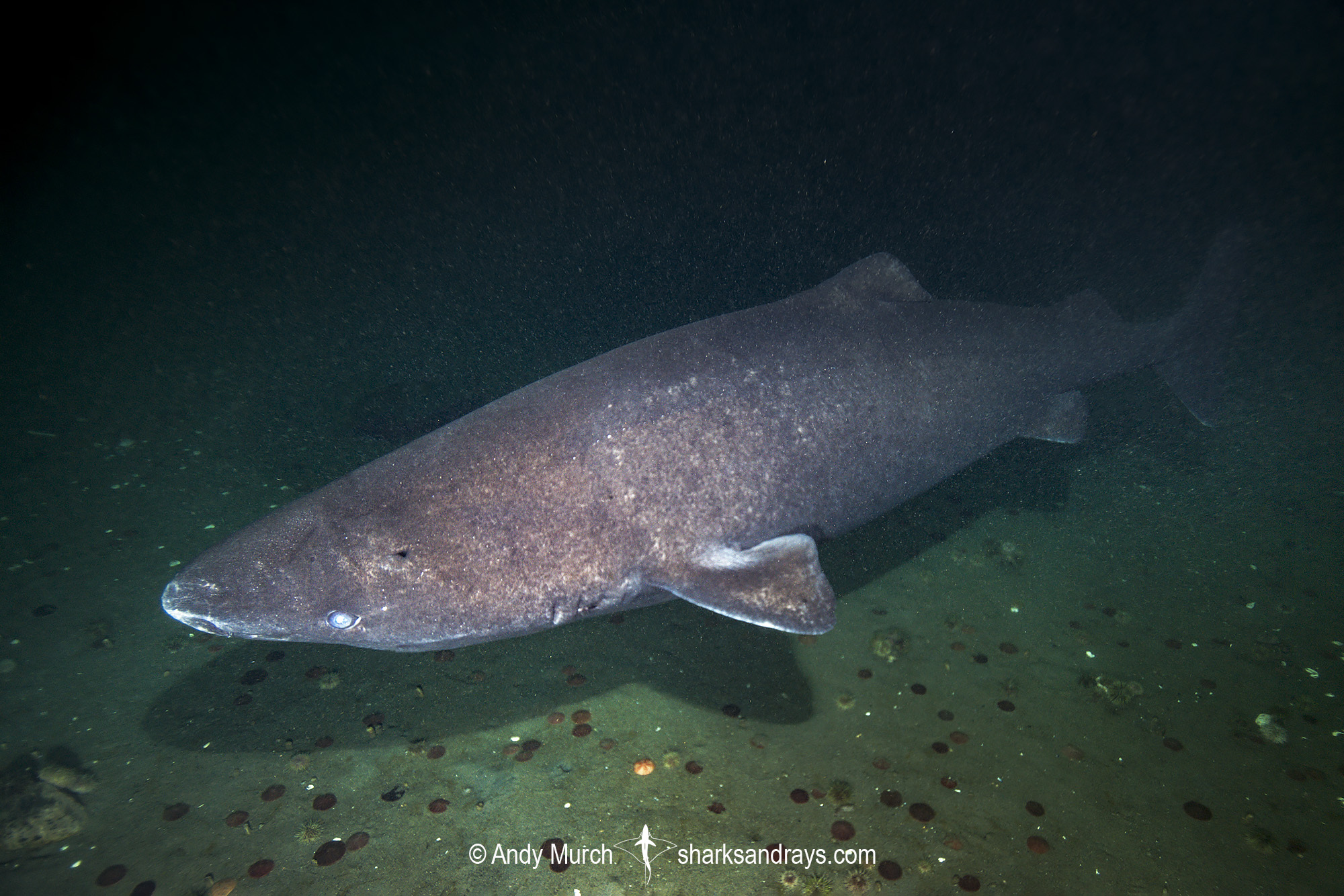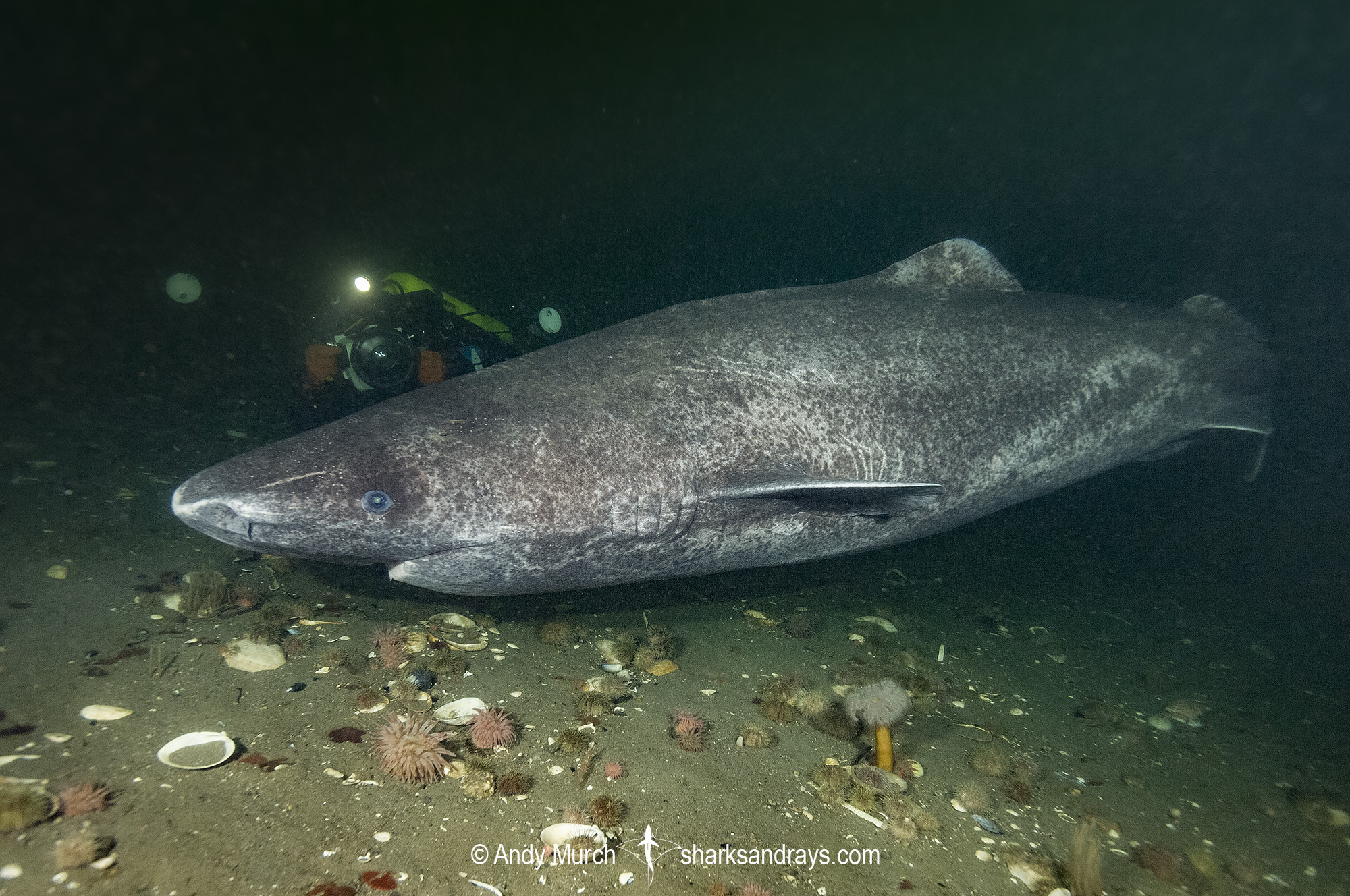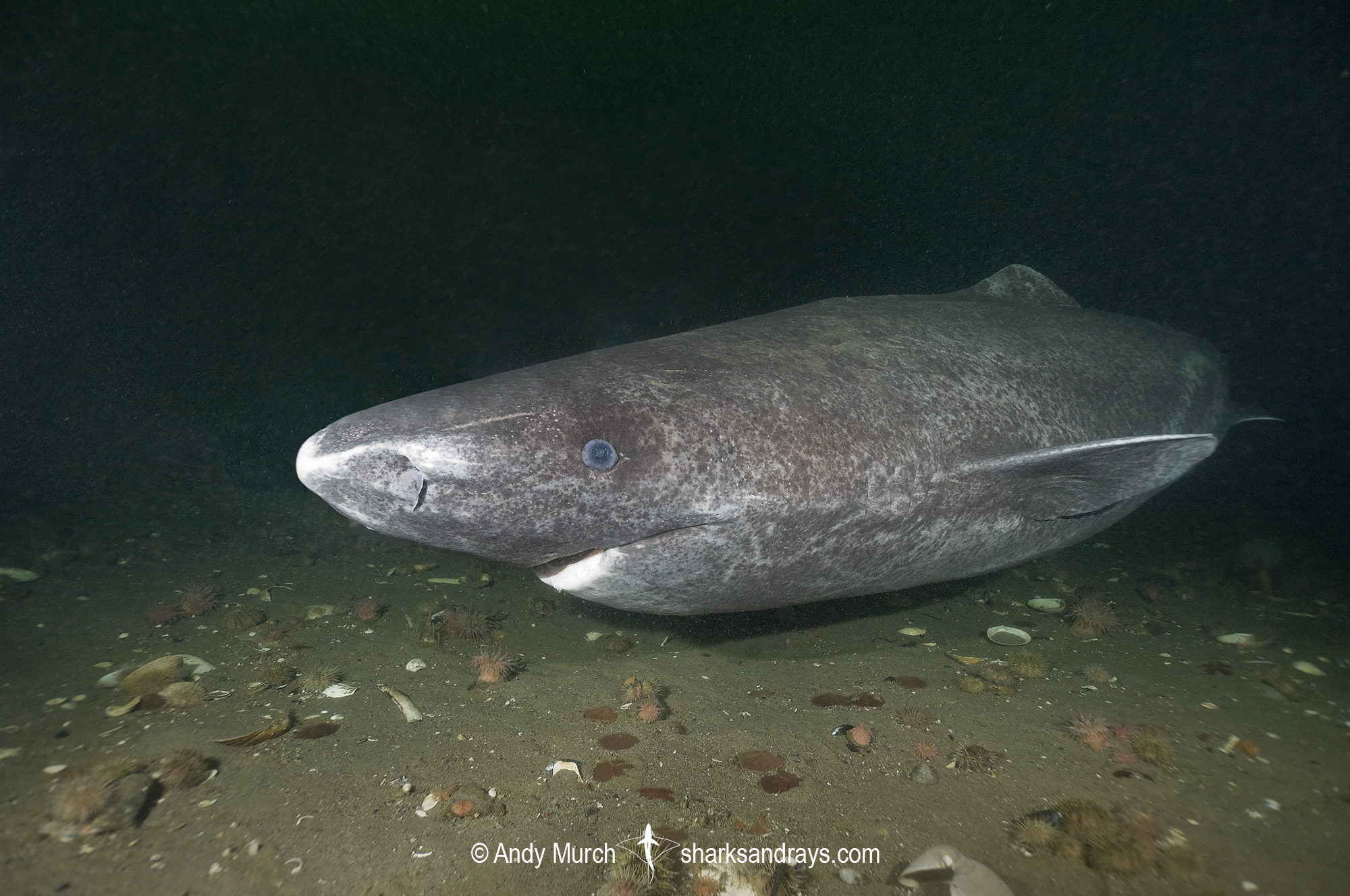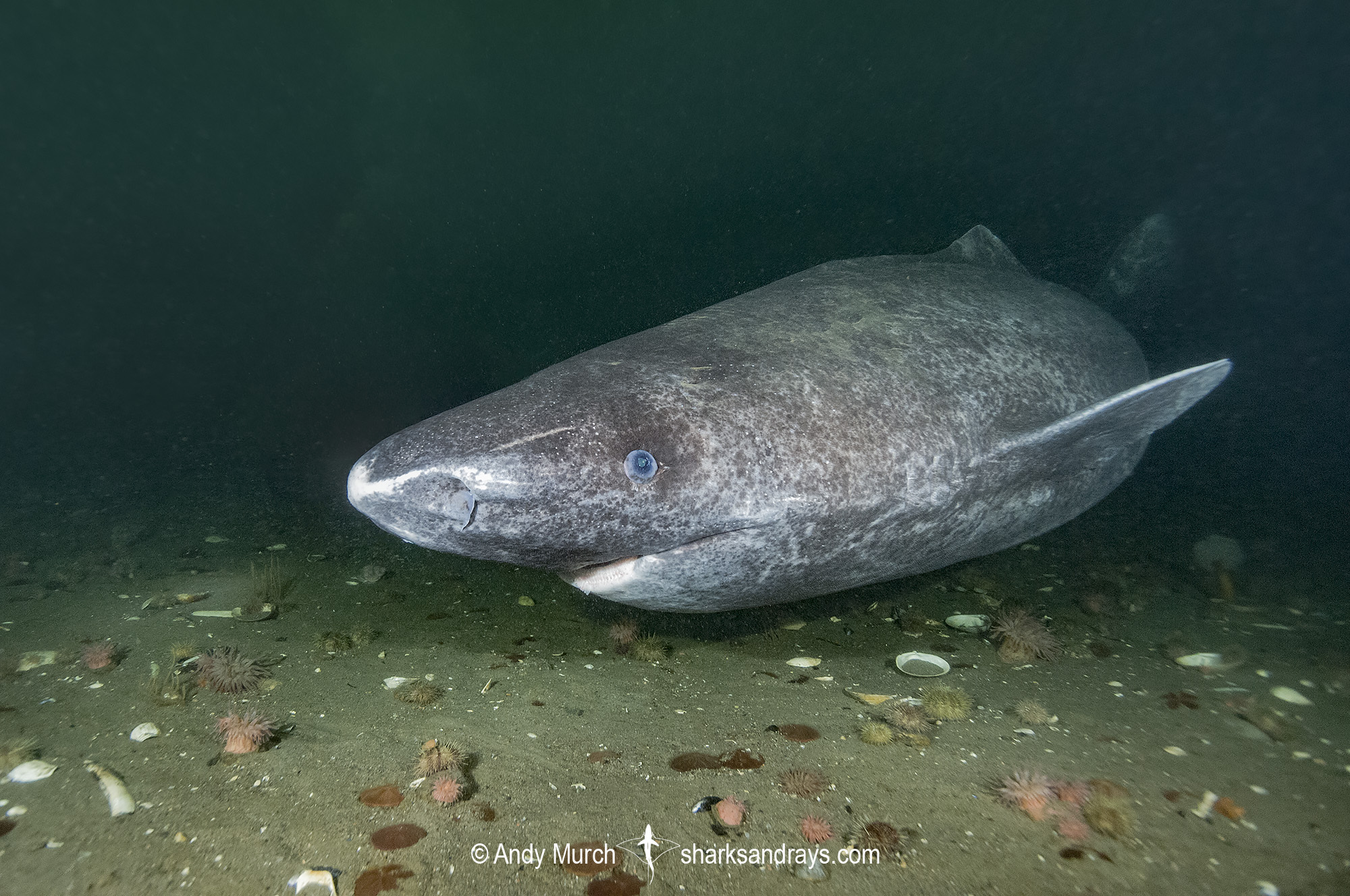Common name(s)
Greenland Shark, Sleeper Shark.
Identification
A very large, heavy-bodied shark with relatively small fins. Snout length roughly equal to mouth width. Small, spiracle behind eye. Eyes often have a parasitic copepod attached. Dorsal fins long and low. First dorsal fin origin midway between pectoral fin free rear tip and pelvic fin origin. Second dorsal origin over pelvic fin insertion. Pectoral fins small with rounded free rear tips. Caudal fin has a weak pre-caudal notch.
Dorsal coloration either mottled or plain grey to brown. Ventrum slightly paler than dorsum.
Size
Maximum length possibly 640cm (Jenkins 1925) but there is a report of a 7.3m specimen. The Greenland shark may be the world’s largest predatory shark, but historical reports may be ‘estimates’. In a study by Hansen in 1963, out of 411 Greenland sharks measured, none exceeded 4m total length. Records of a 5.49m animal by Bigelow and Schroeder seem credible. Size at birth 40-50cm.
Habitat
A boreal / cold-temperate species usually found in deep water of the continental shelf and slope but occasionally enters shallow bays. From the surface to 2647m.
Distribution
North Atlantic Ocean. Found across the high arctic to the southern USA and possibly the Gulf of Mexico, and to northern Portugal. Some evidence suggests that the Greenland shark may also occur around the coast of Antarctica but sightings are likely misidentifications of other sleeper sharks.
Conservation Status
VULNERABLE
The maximum intrinsic rate of population increase (rmax) of the Greenland Shark is 0.032 year−1 which is nearly half the lowest rmax previously calculated for any shark or ray. There have been target fisheries for this species for its for liver oil since the 13th century with an increase in fisheries since the 17th Century (one generation length). Target fishing pressure increased up to the 1900s, ending in the 1940–1960s with the development of synthetic oils. Since then, it has been taken as discarded bycatch of demersal trawl, longline, and gillnet fisheries with approximately 3,500 individuals caught each year in the Northwest Atlantic, Arctic Ocean and Barents Sea. A population reconstruction, based on catch records, reveals that the Greenland Shark has been declining since the early 1600s with steepest declines beginning in the early 1800s through to the 1940s whereupon target fisheries were ended. Since then there is ongoing mortality from bycatch, but the overall fishing mortality is significantly reduced but is close to a level that may cause a decline, depending on bycatch survival rates and population generation length and resilience. The Greenland Shark was estimated to have declined by 57% in the 420 years since the 1600s, but is likely to have increased by 3% in the past century (1920–2020). The global estimated population reduction is 59% over the equivalent of three generation lengths (450 years), but this value could range from 11.7–72.9 depending on whether the generation length is shorter (50–75 years) or longer (274 years). The historic and current catch levels are uncertain, in particular the population reconstruction is likely to be highly sensitive to the catch of adults versus juveniles and post-release survival rate. Most catches seem to comprise juveniles, which might be more sustainable, but the abundance of adults seems very low and uncertain. Further, climate-change induced reduction in Arctic sea ice is providing greater access for fishing fleets and there is a projected loss of Arctic sea ice by 50% over the next 100 years. Taken together, the long history of fishing, ongoing exploitation (albeit at significantly lower levels than historically), and an extremely conservative life history, and climate change impacts of declining Arctic sea ice, it is suspected that the Greenland Shark has undergone a population reduction of 30–49% over the last three generations (450 years). Therefore, the Greenland Shark is assessed as Vulnerable.
Citation
Kulka, D.W., Cotton, C.F., Anderson, B., Derrick, D., Herman, K. & Dulvy, N.K. 2020. Somniosus microcephalus. The IUCN Red List of Threatened Species 2020: e.T60213A124452872. https://dx.doi.org/10.2305/IUCN.UK.2020-3.RLTS.T60213A124452872.en. Downloaded on 16 January 2021.
Reproduction
An aplacental viviparous species (without a yolk-sac placenta). Litter size 7-10. Reproduction cycle probably biennial.
Diet
Feeds on an extremely wide variety of pelagic and benthic fishes (herring, Atlantic salmon, Arctic char, capelin, redfish, sculpins, lumpfish, cod, haddock, Atlantic halibut, Greenland halibut, sharks and skates) as well as marine mammals such as seals and small cetaceans, and sea birds, squids, crabs, amphipods, marine snails, brittle stars, sea urchins, and jellyfish. One animal had the remains of a caribou in its stomach; likely an animal that drowned while swimming between islands rather than direct predation.
Some researchers have theorized that the Greenland shark uses the parasites covering its eyes to lure prey but this seems unlikely as they do not have bioluminescent properties.
Behavior
A very slow swimmer that is probably capable of short bursts of speed when hunting fast moving prey such as pinnipeds and squid.
Reaction to divers
Greenland sharks are easily approached. They usually either tollerate or completely ignore divers but if disturbed, the generally speed up and quickly outpace divers. Sometimes quite curious, making multiple passes before moving on.
Diving logistics
From around 2005 until 2010(?), Greenland sharks started showing up each summer in a shallow bay a few kms east of Baie Comeau, on the north bank of the St Lawrence Estuary in Quebec, Canada. No one was able to ascertain why the sharks visited the area. Jose Castro has suggested that they swim into the brackish bay to kill and shed the parasites that cover their eyes. Although few of the sharks that were seen there had parasites, they were mostly juveniles which could also explain their lack of parasites. I suspect there may have been a whale carcass or other attractant on the seabed nearby that eventually stopped sending out a scent. Whatever the reason, they have not returned.
There are no other spots where divers encounter Greenland sharks but they are known to congregate around Sable Island off the coast of Nova Scotia when the seals are there. This is not an area many divers are able to visit but it might be a good place to try if you have access to a boat.
Some divers at Baie Comeau felt that making noise (e.g. banging their tanks with a metal bar) resulted in Greenland sharks coming in to investigate the noise. I didn’t find this helped very much at B.C. but it is worth a try. Chumming may also be effective but it did not work in Baie Comeau.
What’s new
View our full list of updates
Similar species
Pacific Sleeper Shark In the arctic ocean there may be some overlap in the range of these two enormous sleeper sharks. They cannot be easily distinguished from each other in the field.
Little Sleeper Shark Distinguished by size and more slender appearance. As well as more southerly range.










